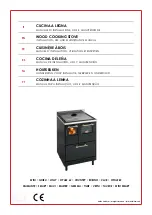
5
Purevision LPV Freestanding
Issue 01 02/21
3.0
Preparation of Stove for Installation
.
Your stove comes fully assembled, checked and packed in a protective plywood crate.
Carefully remove the straps and lift off the top and upper crate. Remove any plastic packaging,
open the door and remove all the contents. See List of Components section (above) and check
contents carefully.
3.1.
Remove the top plate by lifting it off.
3.2.
If required remove the rear casing by removing rear casing brackets and lifting it off.
3.3.
Remove the interior components of the stove using the following procedure. SEE ALSO
MAINTENANCE GUIDE section for diagrams where required.
3.3.1.
Remove the baffle plate by supporting the plate with both hands and lifting the front
edge towards you and sliding the back edge off the back support and down slightly into
the firebox. Once the rear is lowered then the front edge can also be lowered off the
front baffle supports.
3.3.2.
Next remove the fuel retainer bar and its supports by lifting the supports carefully out
of the slots in the base ceramics.
3.3.3.
Now remove the rear firebox liner(s). Handle and store these ceramic liners very
carefully to one side where they will not get broken.
3.4.
Rock the stove to the rear and left and right side in turn and set the adjustable feet of the
stove until they stand proud of the base casing
–
or remove them if the stove is to be
mounted onto a stand, pedestal, wall mounting bracket or log store.
3.5.
The flue spigot collar may now be configured for horizontal connection if required.
3.5.1.
Remove the 6 x M6 cap screws within the upper rear firebox and remove the spigot
assembly.
3.5.2.
The rear casing blanking plate is pre-cut by laser can now be taken out by removing
the retaining tabs which hold it in place.
3.5.3.
Finally, the spigot may then be rotated by 180 degrees and re-fitted horizontally
either using the gasket provided or re-sealing with fire cement or suitable high
temperature fireproof sealant as required.
3.5.4.
The casing upper blanking plate can now be used to cover the hole in the top plate.
3.5.5.
The casing infill plate is used to cover the upper area above the horizontal rear spigot.
3.6.
Lift the stove into its final position using an assistant to help.
3.7.
Make the connection to the flue, chimney or liner using appropriate adjustable rigid flue
pipe or adaptor, making sure to seal all joints carefully.
3.8.
Now proceed to complete the installation of the stove according to these instructions,
Building Regulations and current installation standards or HETAS advice.
3.9.
The internal parts of the stove can be re-assembled as the reverse of the previous removal
instructions.







































